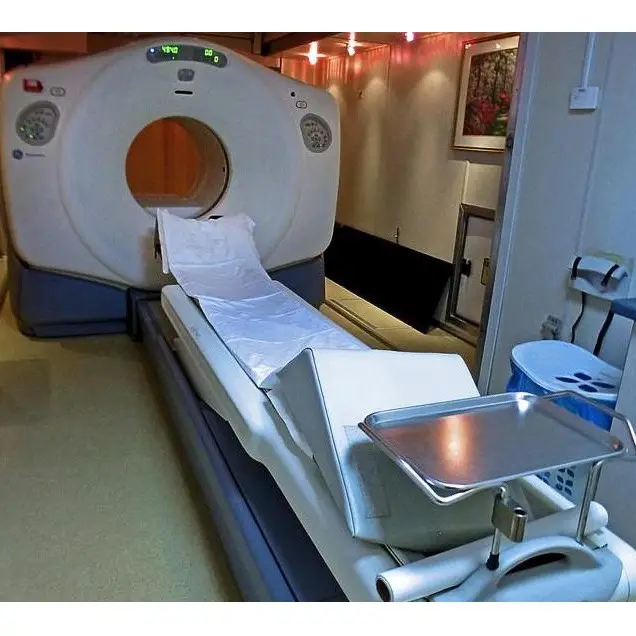
In the realm of medical imaging, PET scans have emerged as invaluable tools for diagnosing and monitoring a wide range of diseases. This non-invasive procedure utilizes radioactive tracers to provide detailed images of the body’s metabolic activity, revealing abnormalities that may not be visible on traditional X-rays or CT scans. In this comprehensive guide, we delve into the intricacies of PET scans, exploring their mechanisms, applications, and potential side effects.
Understanding the PET Scan Process

A PET scan, or positron emission tomography, is a nuclear medicine imaging procedure that measures the distribution of radiotracers in the body. These radiotracers, injected into the bloodstream, accumulate in tissues with high metabolic activity, allowing doctors to visualize areas of increased energy consumption. This information is crucial for diagnosing and monitoring a variety of conditions, including cancer, heart disease, and neurological disorders.
According to National Health Service (NHS), “You lie on a flat bed that has been rolled into a huge, cylindrical scanner to undergo the scan. While the scanner captures photographs of your body, remain motionless and silent. Thirty to sixty minutes is the average scan time. Although there is no pain involved in the scan, it could be unsettling for you to lie still for so long.”
The Step-by-Step Procedure
The PET scan procedure is relatively straightforward and painless. Here’s a step-by-step guide to what you can expect:
- Radiotracer Injection: A small amount of radiotracer, typically fluorodeoxyglucose (FDG), is injected into a vein in your arm.
- Uptake Period: You will be asked to rest quietly for approximately 30 to 60 minutes to allow the radiotracer to accumulate in active tissues.
- Scanning Process: You will lie on a narrow examination table that slides into a large, doughnut-shaped PET scanner. The scanner will rotate around your body, detecting the emitted radiation from the radiotracer.
- Image Generation: The scanner generates detailed images of the radiotracer distribution, providing insights into the body’s metabolic activity.
- Interpretation: A radiologist will analyze the PET scan images to identify areas of abnormal metabolic activity, which may indicate the presence of disease.
Unveiling the Benefits of PET Scans
PET scans offer a multitude of benefits, including:
- High Sensitivity: PET scans can detect subtle changes in metabolic activity, making them highly sensitive for identifying early stages of disease.
- Specificity: PET scans are relatively specific, meaning they accurately pinpoint the location of abnormal metabolic activity, reducing the likelihood of false positives.
- Whole-Body Imaging: PET scans provide a comprehensive view of the body, allowing for the detection of abnormalities in multiple organs and tissues simultaneously.
Addressing Common Concerns
While PET scans are generally considered safe, some concerns may arise:
- Radiation Exposure: PET scans involve exposure to a small amount of radiation. However, the risk of radiation-induced side effects is minimal.
- Allergic Reactions: Some individuals may experience mild allergic reactions to the radiotracer.
- Pregnancy and Breastfeeding: Pregnant women should inform their doctor if they are pregnant or breastfeeding, as the radiotracer may affect the developing fetus.
Preparation and Post-Procedure Care

To prepare for a PET scan, follow your doctor’s instructions carefully. This may include:
- Dietary Restrictions: Fasting for several hours before the scan may be necessary to ensure accurate readings.
- Medication Management: Discuss any medications you are taking with your doctor, as some may interfere with the scan results.
- Comfortable Clothing: Wear loose-fitting, comfortable clothing that you can easily change in and out of.
After the PET scan, resume your normal activities. The radiotracer will gradually leave your body through urine and feces. Drink plenty of fluids to help flush out the radiotracer more quickly.
Exploring the Cost Factor
The cost of a PET scan can vary depending on the location, the type of scan, and insurance coverage. In general, PET scans are more expensive than traditional X-rays or CT scans.
Navigating the Insurance Landscape
If you have health insurance, check with your provider to determine if they cover PET scans. If you have a high deductible, you may be responsible for a portion of the cost.
Seeking Financial Assistance
If you are uninsured or have limited financial resources, there are organizations that may provide assistance with the cost of PET scans.
Conclusion
PET scans have revolutionized medical imaging, providing valuable insights into the body’s metabolic activity and aiding in the diagnosis, staging, and treatment planning for a wide range of diseases. Their high sensitivity, specificity, and whole-body imaging capabilities make them essential tools for modern healthcare. As research and technology continue to advance, PET scans are likely to play an even more prominent role in improving patient
Read More
- Eating Right | Why And Benefits OF Healthy Eating
- BEST FRUITS TO CONSIDER FOR A HEALTHY DIET
- 10 Healthy Benefits of Morning Sex
- The health Benefits of Ginger: Spice Up Your Wellness Routine
- The Health Benefits of Herbs and Spices
Frequently Asked Questions (FAQs)
What is a PET scan?
A PET scan (positron emission tomography) is a medical imaging procedure that uses radioactive tracers to visualize metabolic activity in the body. It is used to diagnose a variety of conditions, including cancer, heart disease, and neurological disorders.
How does a PET scan work?
A PET scan is performed by injecting a radioactive tracer into the patient’s bloodstream. The tracer is absorbed into cells that are using glucose, a type of sugar. The tracer then emits positrons, which are antiparticles of electrons. When a positron encounters an electron, they annihilate each other, releasing two photons. These photons are detected by a scanner, which uses this information to create a detailed image of the patient’s body.
What is a tracer?
A tracer is a radioactive substance that is used to visualize metabolic activity in the body. There are many different types of tracers, but the most common tracer used in PET scans is fluorodeoxyglucose (FDG). FDG is a sugar molecule that is similar to glucose, but it is not metabolized by the body in the same way. Instead, FDG is taken up by cells that are using glucose, which means that it can be used to image areas of high metabolic activity, such as tumors.
How long does a PET scan take?
The entire PET scan procedure, including the preparation, injection, and scanning, typically takes about 2-3 hours. The actual scanning time is usually about 30-60 minutes.
What should I expect during a PET scan?
Before the scan, you will be asked to change into a hospital gown and remove any jewelry or metal objects. You will then be injected with the radioactive tracer. You may feel a brief cold sensation as the tracer is injected. After the injection, you will need to wait for the tracer to be absorbed into your cells. This usually takes about 30-60 minutes. During this time, you will be asked to lie still on a scanning table. The scanner will make a buzzing noise, but the procedure is painless.
Are there any risks associated with PET scans?
The amount of radiation exposure from a PET scan is very low. The benefits of the scan typically outweigh the risks. However, PET scans are not recommended for pregnant women or women who are breastfeeding.
What are the uses of PET scans?
PET scans are used to diagnose a variety of conditions, including:
- Cancer: PET scans can be used to detect cancer, determine the stage of cancer, and assess the effectiveness of cancer treatment.
- Heart disease: PET scans can be used to identify areas of the heart that are not receiving enough blood flow. This information can be used to diagnose coronary artery disease and other heart conditions.
- Neurological disorders: PET scans can be used to diagnose and monitor neurological conditions such as Alzheimer’s disease, Parkinson’s disease, and epilepsy.
What are the limitations of PET scans?
PET scans are not as good as MRI scans or CT scans at imaging bones and soft tissues. Additionally, PET scans can sometimes produce false-positive results, which means that they may indicate a problem when there is none.
How much does a PET scan cost?
The cost of a PET scan can vary depending on the hospital or clinic where the scan is performed. However, PET scans are typically very expensive, costing several thousand dollars.


